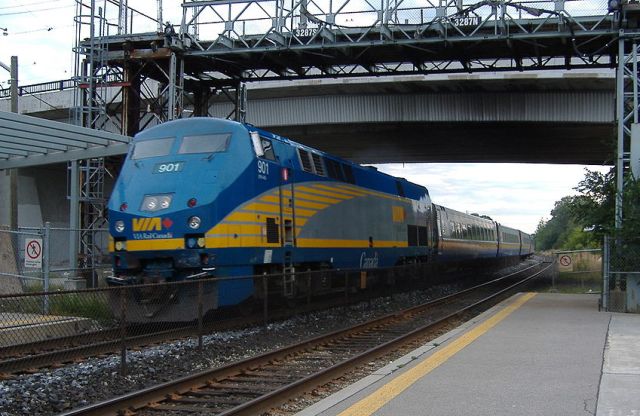
Via Rail eyes $4B plan to slash Toronto-Ottawa-Montreal travel times
by Terry Pedwell, The Canadian Press

It isn't a high-speed rail, but Via says its plan to build dedicated tracks will get cars off the road by offering quicker alternative

The new plan would cut travel times between Ottawa and Toronto to 1:30; between Ottawa and Montreal to 1:20; and between Toronto and Montreal to 3:45. PHOTO: Andrew Dolch, via Wikimedia Commons
OTTAWA—Via Rail will ask the federal government by year’s end to climb aboard a plan to run new “high-frequency,” electric-hybrid trains in the busy Windsor-Quebec City corridor, the head of the Crown corporation says.
With any luck, the $4-billion project will be “shovel ready” a year from now, with the first of the new fleet carrying passengers by 2019, says Via president and CEO Yves Desjardins-Siciliano.
“The fall of 2019, the dedicated corridor would exist between Montreal, Ottawa and Toronto at a minimum and even possibly all the way to Quebec City at that point,” he predicted in an interview with The Canadian Press.
Via has been promoting its plan to build tracks dedicated to passenger rail service since 2014, just five years after its proposal for a high-speed service withered under the weight of the recession. The crown corporation says its dedicated track plan would cut travel times between Ottawa and Toronto to 1:30; between Ottawa and Montreal to 1:20; and between Toronto and Montreal to 3:45.
But the proposal was recently refined to focus on building electrified tracks after Justin Trudeau was elected with a Liberal government committed to spend massively on infrastructure projects.
The plan, which would involve private funding, falls in line with the federal Liberal government’s stated desire to construct “green” infrastructure, said Desjardins-Siciliano.
“There’s a perfect alignment between this government’s desire to have generational, transformative projects that are a step-change in Canada’s modernization, with this project,” he said.
It also fits with a report to Parliament in February which called for “private-sector approaches” to improving both passenger and freight rail services in Canada.
Via has been openly courting public-sector pension funds eager to invest in long-term, stable projects, to gauge interest in its plan, until it gets the green light from Ottawa to formally solicit partners.
Private-sector investment could come in the form of a public-private partnership to help offset the costs of construction, or an equity investment.
Desjardins-Siciliano said he has had discussions with the Canada Pension Plan Investment Board, the Ontario Teachers’ Pension Plan and the Ontario Municipal Employees Retirement System among others.
The “high-frequency” aspect of Via’s proposal appears out of sync with the Ontario government’s appetite for faster train service, however.
In October, the province appointed former federal cabinet minister David Collenette as a special adviser on “high-speed” rail, with a mandate to make a business case for building a rail link from Windsor through communities in southwestern Ontario to Toronto.
Desjardins-Siciliano’s plan envisions the construction of dedicated passenger rail lines for trains that would travel at an average speed of 110 kilometres an hour, initially along a corridor from Toronto to Montreal, with stops in several communities along the way.
Until 2009, Via had promoted a lofty plan to construct a high-speed rail service for the Windsor-Quebec City corridor.
But that plan no longer makes either economical or practical sense, said Desjardins-Siciliano, who sees Via competing with passenger cars rather than airlines to get people from city to city.
He cites Europe as an example of where high-speed trains are readily available, but not in high use, because they are not as economical as flying and don’t make frequent stops.
Last month’s federal budget set aside $3.3 million over three years to study the viability of Via’s dedicated rail line proposal, but made no commitments to pay for the construction itself.
The Railway Association of Canada predicted the plan would relieve congestion on highways in the Toronto-Ottawa-Montreal corridor, and reduce passenger travel times between the cities.
Via said the dedicated rail plan would cost approximately $2 billion for rail infrastructure and signals; $1 billion for the rolling stock and stations; and $1 billion for electrification. If allowed to move forward, the project will also create about 26,000 person-years of work throughout construction.